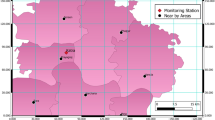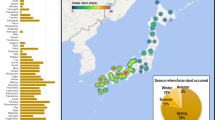Abstract
Objective
PM10 is one of the typical pollutants involved with sandstorm. More and more attentions on the sensitive bio-marks by PM10 exposure are attracted. This study is to probe the sensitivities indicators’ levels by sandstorm PM10 exposure.
Methods
A cross-sectional study involving administration on a survey 150 residents in Erlianhaote was performed. PM10 concentrations collected on a daily basis from the local monitor stations from March to June, 2016 were employed as the daily environmental exposure levels (DEEL). Indicators of IGM, CRP, CC16, IL16, IGA, LGG, IGE and IL8 were assayed, as well as questionnaire for individual disease histories were done.
Results
Results indicated that PM10 exposure level was positively related to IGG, IGM, IGA, LGG and CRP, age was positively related to CRP and LGG, and history of cardiovascular disease was related to CRP by multi-factor line regression analysis. Further analysis revealed that levels of IGG (p<0.01) and IGM (p<0.05) increased in the group with PM10 DEEL exceeded 200 μg/m3, compared to the group with the average exposure levels less than 200 μg/m3; while levels of IGM (p<0.05), IGA (p<0.05), LGG (p<0.05) and CRP (p<0.01) were found higher in the group with PM10 DEEL exceed 300 μg/m3, compare to the group with the levels less than 300 μg/m3.
Conclusion
Our findings suggest that sandstorm PM10 exposure might contribute to the changes of some immune and inflammation index. These findings provide clinical indicators for the sandstorm PM10 exposure and help to understand the risk of sandstorm pollution.
Similar content being viewed by others
References
Chen, F. et al. Does temperature modify the effect of PM10 on mortality? A systematic review and metaanalysis. Environ. Pollut. 224, 326–335 (2017).
Sajani, S. Z., Hänninen, O., Marchesi, S. & Lauriola, P. Comparison of different exposure settings in a case—crossover study on air pollution and daily mortality: counterintuitive results. J. Expo. Sci. Environ. Epidemiol. 21, 385–394 (2011).
Zanobetti, A. & Schwartz, J. The Effect of Particulate Air Pollution on Emergency Admissions for Myocardial Infarction: A Multicity Case-Crossover Analysis. Environ. Health Perspect. 113, 978–982 (2005).
Downs, S. H. et al. Reduced Exposure to PM10 and Attenuated Age-Related Decline in Lung Function. N. Engl. J. Med. 357, 2338–2347 (2007).
Yuan, Z. in Effects of air pollutants on the inflammatory cytokines in rats (Jilin university, China, 2008).
Yang, C., Renqun, W., Su, Z. & Chunling, X. Effect of mixed air pollutants on the levels of interferon-γ and CC16 in bronchoalveolar lavage fluid of rats. J. China Med. Univ. 36, 436–437 (2007).
Miao, J. & Sang, N. PM_(10) Exposure Induces Myocardial Injuries in Rats. J. Shanxi Univ. 37, 648–652 (2014).
Sakamoto, N. et al. Effect of atorvastatin on PM10-induced cytokine production by human alveolar macrophages and bronchial epithelial cells. Int. J. Toxicol. 28, 17–23 (2009).
Nguyen, T. T. et al. A Longitudinal Study of Association between Heavy Metals and Itchy Eyes, Coughing in Chronic Cough Patients: Related with Non-Immunoglobulin E Mediated Mechanism. Int. J. Environ. Res. Public Health 13, doi: 10.3390/ijerph13010110 (2016).
Lihua, G. et al. Effect of PM10 on human immunological parameters. J. Zhengzhou Univ. Med. Edition 43, 546–548 (2008).
Li, X. Y., Gilmour, P. S., Donaldson, K. & Macnee, W. Free radical activity and pro-inflammatory effects of particulate air pollution (PM10) in vivo and in vitro. Thorax 51, 1216–1222 (1996).
Liu, X. C. et al. Analysis of mass concentration of atmospheric particulate matter in a sandstorm course and its affecting factors in the Taklimakan Desert. Sci. Cold Arid Region 4, 259–264 (2012).
Zhang, F. et al. Ambient air quality and the effects of air pollutants on otolaryngology in Beijing. Environ. Monit. Assess. 187, doi:10.1007/s10661-015-4711-3 (2015).
Wong, C. M. et al. Cancer Mortality Risks from Longterm Exposure to Ambient Fine Particle. Cancer Epidemiol. Biomarkers Prev. 25, 839–845 (2016).
Chen, B. & Kan, H. Air pollution and population health: a global challenge. Environ. Health Prev. Med. 13, 94–101 (2008).
Zeka, A., Zanobetti, A. & Schwartz, J. Short term effects of particulate matter on cause specific mortality: effects of lags and modification by city characteristics. Occup. Environ. Med. 62, 718–725 (2005).
Golomb, E. et al. Myocardial mitochondrial injury induced by pulmonary exposure to particulate matter in rats. Toxicol. Pathol. 40, 779–788 (2012).
Dong, S. et al. Ambient Particulate Pollutants and C Reactive Protein Variability in Elderly Residents in Beijing. J. Environ. Health. 28, 1035–1039 (2011).
Liang, L., Yates, A. P., Mather, E. & Pickersgill, M. in Society for Endocrinology Meeting. 414–416.
Thompson, D., Pepys, M. B. & Wood, S. P. The physiological structure of human C-reactive protein and its complex with phosphocholine. Structure 7, 169–177 (1999).
Shao, Y. & Dong, C. H. A review on East Asian dust storm climate, modelling and monitoring. Glob. Planet. Change 52, 1–22 (2006).
Author information
Authors and Affiliations
Corresponding author
Electronic supplementary material
Rights and permissions
About this article
Cite this article
Lv, S., Wang, H., Wang, B. et al. Study on the Sensitivity Indicators by Sandstorm PM10 Exposure. Toxicol. Environ. Health Sci. 10, 65–71 (2018). https://doi.org/10.1007/s13530-018-0348-2
Received:
Revised:
Accepted:
Published:
Issue Date:
DOI: https://doi.org/10.1007/s13530-018-0348-2




